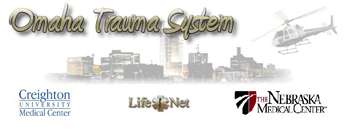 For 15 years, the city of Omaha has taken a special approach to treating trauma patients.
For 15 years, the city of Omaha has taken a special approach to treating trauma patients.
The Omaha Trauma System consists of the two academic medical centers in Omaha — UNMC’s hospital partner, The Nebraska Medical Center, and Creighton University Medical Center — along with Life Net helicopter. Together, these entities combine to treat critically injured patients from around the metro.
For the first time ever, the state of Nebraska has designated both hospitals as Comprehensive Trauma Centers, its highest designation.
The Nebraska Medical Center and CUMC are the only hospitals in the state to receive this designation.
These two trauma centers each take the trauma cases on a given day. Paramedics bring trauma patients to CUMC on Mondays, Wednesdays, Thursdays and Saturdays. The Nebraska Medical Center is the trauma hospital Tuesday, Friday and Sunday. Each hospital has a trauma surgeon, orthopedic surgeon and a neurosurgeon on standby during its designated trauma period. Operating rooms also are on standby.
To achieve designation, strict criteria have been set by the State of Nebraska. State reviewers along with out-of-state trauma surgeons and program managers from other trauma centers spend a full day at each hospital looking closely at the trauma system and patient charts to ensure that care meets or exceeds national standards of care. Reviewers also tour each facility to make sure the proper equipment is available and adequate space is devoted to each trauma patient. This year, the reviewers came from a major trauma center in Las Vegas.
Along with review of equipment, facilities and charts, a review of the process improvement and peer review is a major part of the designation visit. Reviewers audited meeting minutes and records of trauma cases to make sure each hospital continually analyzes and improves its processes.
“This part of the process keeps us looking forward,” said Diane Yetter, coordinator of the trauma program at The Nebraska Medical Center. “It’s good to get input and perspective from other large trauma centers.”
“We have a unique situation in Omaha, to have a formal trauma service offered by two academic medical centers,” said CUMC Trauma Coordinator Megan Sorensen. “This relationship provides high quality health care to our community’s trauma victims and to all our surrounding communities.”
Omaha’s two hospital trauma system was put to the test after the Dec. 5, 2007 shooting at the Westroads Mall.
|
Both CUMC and The Nebraska Medical Center treated critically wounded patients from that tragedy.
“These surviving patients are living examples of the success of the two-hospital trauma system,” said Joseph Stothert, M.D., professor of surgery at UNMC and trauma medical director for The Nebraska Medical Center and the state of Nebraska. “When you need it, as in the case of a mass casualty situation, you have two hospitals prepared to treat patients as opposed to just one.”
Trauma teams at both medical centers are involved with more than just treating patients in their hospitals. The trauma coordinators also are focused on outreach and education.
Sixty percent of trauma patients come to CUMC and The Nebraska Medical Center from inside Douglas County. Eighteen percent come from Iowa and the remaining 22 percent of patients come from areas in Nebraska outside of Douglas County.